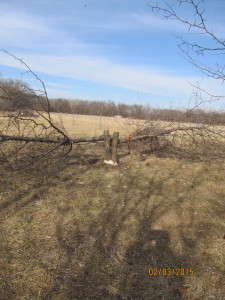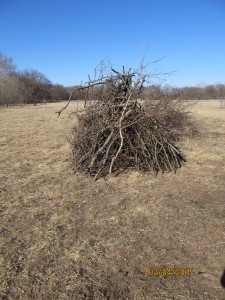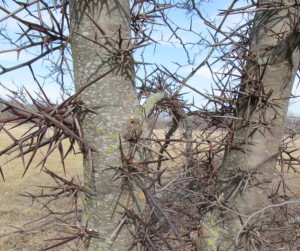During January and February I cut down thorny locust trees on my property. If pastures are not mowed every year, one of the first volunteer trees to pop us is the thorny locust. these trees grow sharp thorns on the trunk and on the limbs – discouraging cattle and other mammals from getting close. Some fields in the nearby areas have not been maintained and the thorny locust trees are so thick that the branches mingle together and form a thicket that would be difficult for cattle or humans to enter.
The first picture shows two trees before felling – I say two trees although it appears they may be growing from the same stump. As shown in second picture the thorns can be three or four inches long. I used hand tools (pruning saw, pruners, and axe) to work on the trees. To cut the trunk I first cut off a lot of the thorns and limbs to enable me to get close. This reduces the number of times I get poked later on. The thorns even puncture through the leather boots that I wear. Today when my skin is punctured the pain usually does not last long, although two years ago when I encountered the first thorn and lost, the wound ached for about four months.
I cut the trees off about four feet above ground as shown in the picture above. Since I do not have a convenient way to get rid of the stump completely, I will be able to see the stump when I mow the field next summer. Judging from the rings on the stumps of the cut down trees, the oldest trees on my property are about ten years old as indicated in the picture below. Of course there are many smaller trees that are not so old. The oldest trees are 20 to 30 feet tall and the trunk diameter at four foot above ground is about nine inches.
Because the thorns on the limbs have a way of locking together that prevents close packing, after cutting down the tree I cut the limbs off so they will settle down onto the brush pile as in the picture below. Going from previous experience the wood in the brush pile should be dry enough to burn in a few months – and, it will burn quite fast.
I have never tried to make mulch from thorny locust trees because the thorns remain very sharp after drying out and the needle points on many would probably remain whole even after going through a shredder. My father had many flat tires on his tractors due to thorns on his Illinois farm. Although there remain many thorny locust trees to be cut, I have cut down most of the larger ones. For now I am halting work on this task because many other more pressing tasks need to be attended to.
